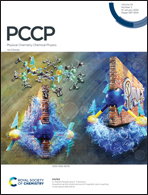The electronic temperature and the effective chemical potential parameters of an atom in a molecule. A Fermi–Dirac semi-local variational approach†
Abstract
We developed a numerical procedure to compute the electronic temperature and the effective (local) chemical potential undergone by electrons belonging to a particular molecular species. Our strategy relies on consider atomic basins as open quantum (sub)systems within the context of the quantum theory of atoms in molecules. Each basin is represented by the two parameters, the electronic temperature and the effective chemical potential, which are determined by distributing electrons (fermions) imbedded in each atomic region, through a Fermi–Dirac semi-local variational procedure. The results obtained for 40 different chemical species show that the effective chemical potential is a useful tool to reveal the most acidic/basic atoms in a molecule while the electronic temperature is closely related to the concept of chemical hardness at the local level. Our numerical data also indicate that the electronic temperature values undergone by electrons imbedded in atomic basins are way beyond the room temperature condition, allowing to fractionally occupy several of the one-particle quantum states. In this context, we developed two new indexes useful to reveal outstanding orbitals involved in the chemical reactivity of atoms in molecules.



 Please wait while we load your content...
Please wait while we load your content...